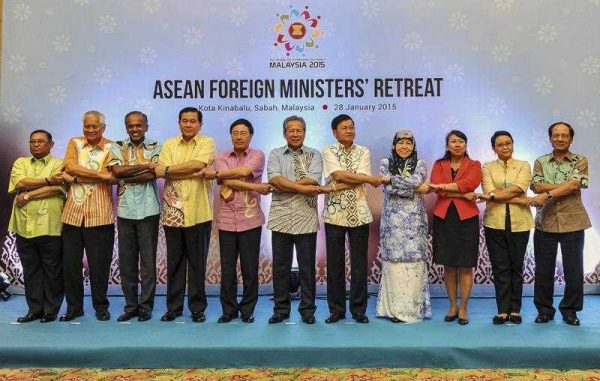When ASEAN adopted the AEC in 2003, it wanted to cement economic cooperation — lowering trade and investment barriers and harmonising rules and regulation — and to find ways to place the region in global value chains. The integration objective of the AEC (which will lead to the creation of a ‘single market and production base’) is likely to generate higher welfare gains than the tariff liberalisation initiative of the ASEAN Free Trade Area in the 1990s.
After more than a decade, the AEC has achieved 82.1 per cent of its stipulated targets. But ASEAN is far from delivering a single market. Tariffs have been lowered, but non-tariff barriers continue to hamper trade in the region. Despite the ASEAN Single Window being ready and key agreements to facilitate trade and investment are already in practice, the region suffers from a lack of infrastructure. Income gaps between member countries have fallen, though they are still large. And while ASEAN has signed FTAs with its major interregional trading partners, its intraregional services sector negotiations have resulted only in marginal liberalisation, mainly due to the lack of policy alignment between regional and domestic economies.
But what about the strategic rationale?
The context of the AEC’s inception was interesting. The Asian Financial Crisis of 1997–98 caused havoc in financial systems and a slump in the real economy. ASEAN’s strategic response to the crisis was a decision to deepen economic cooperation, using the AEC as a ‘hub’. The crisis prompted ASEAN to recognise the importance of economic and financial cooperation in the broader Asian region and to institutionalise such interdependence.
At the same time, China had been growing as a target for its market and production base. In the 1990s, trade and investment was already being diverted from ASEAN to China. Deeper integration would increase ASEAN nations’ global competitiveness and stem the investment diversion. ASEAN’s initiative to move towards the AEC can also be viewed as a defensive move against the growth of regional trading arrangements (such as the expansion of the EU and the success of NAFTA).
As a strategic project, the AEC was designed to help its member states pursue their national interests. By becoming economically cohesive, the ten small economies could work together to reduce economic and financial vulnerability while also providing a bigger and attractive market space of 600 million people to foreign investors. An economically cohesive region was likely to strengthen the member states’ bargaining power in the WTO, in negotiating FTAs and in other strategic matters.
Has the AEC project been successful in its strategic motive? Although nothing can be precisely attributed to the AEC, ASEAN member states did pull through the 2008 Global Financial Crisis relatively smoothly. Member governments acted quickly to adopt responsive measures. Global economic issues and uncertainties are regularly discussed in ASEAN meetings. ASEAN maintains its unity and works as a hub in the Asian regional architecture, even while negotiating FTAs with large economies.
Another step towards placing ASEAN at the heart of regional economic strategy occurred in November 2012, when the ASEAN Leaders announced the Regional Comprehensive Economic Partnership, which is said to be built on ASEAN’s experience and is expected to bring together all five of the ASEAN+1 FTAs into an integrated regional economic framework.
The success of the AEC can be observed in ASEAN’s assertive manner in dealing with the international community. For instance, in April 2009, ASEAN (as an organisation) was invited to join the world’s leading economies at the G20 summit in London for the first time. In 2010, ASEAN engaged the US through the East Asia Summit. ASEAN’s growing international recognition can also be seen by the appointment of more than 75 separate ambassadors to ASEAN.
Going forward, the AEC — as a strategic project — will continue to be developed to attract more FDI into the region, help member countries participate in global supply chains, and strengthen member countries’ bargaining power in international economic, financial and strategic matters. And that has to be a good thing for ASEAN.
Sanchita Basu Das is an ISEAS Fellow and Lead Researcher (Economic Affairs) at the ASEAN Studies Centre, ISEAS, Singapore. She is also the coordinator of the Singapore APEC Study Centre.


Thank you for taking an accurate, broad view of ASEAN integration, including via the AEC.
ASEAN is looking good compared to the distrust and divergence that may yet tear the Eurozone and even the EU apart,
Best wishes
Andrew